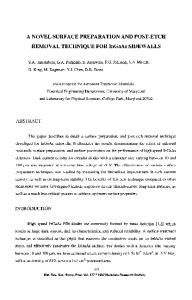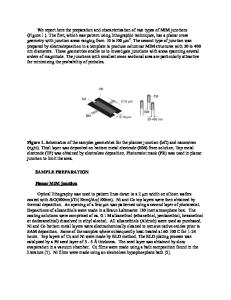Post Metal Etch Treatment for Submicron Applications
- PDF / 2,376,201 Bytes
- 7 Pages / 414.72 x 648 pts Page_size
- 49 Downloads / 412 Views
Mat. Res. Soc. Symp. Proc. Vol. 477 ©1997Materials Research Society
D. Wet chemical deveil removal: The final process in the metal etch scheme is to remove the veil formation on the sidewalls of the etched structure. Electrical shorts can be caused by the veil material bridging between metal lines, or degradation of the line integrity (conversion of bulk aluminum to aluminum chloride) that contributes to electrical opens and electromigration failures. Common deveil processes/chemistries are defined in Table I. Type A
Chemistry HF-Glycol
B
TMAH(Tetra Methylammoniahydroxide) 2(Aminoethoxy) ethanol N-Methyl pyrrolidone Ethanol-amine base
C D
Table I - Deveil Chemistries Application Pros Post Metal Removes tough Etch veils Post Metal Nominal metal line Etch erosion, track dispense Post Metal Good corrosion Etch, Via and control, minimal Contact metal line erosion Post Metal Removes tough Etch, Via and metal etch veils Contact
Cons Undercuts Ti/TiN, metal line lifting, particles Removes only light metal veil formations Particles in batch system, Nominal removal of heavy metal etch veils C02 sparge in rinse needed to reduce aluminum undercutting, batch system.
EXPERIMENTAL STUDY System Description: The etch tool used in this study was the Lam 9600 that uses transformer coupled plasma (TCP) technology. In situ resist pattern removal is through the use of a down stream quartz (DSQ) stripper module (02, H20, CF4) located at the exit load lock. Corrosive components remaining on the surface of the wafers from the chlorinated plasma process are removed by an atmospheric passivation module (APM) equipped with a hot nitrogen and cold or hot deionized water rinse [6]. All tests were performed on 150mm wafers with metal stack of Ti/TiN/AlCu/TiN. Deveil Process Studied: The two processes studied were Chemistry B and Chemistry C with a standard DSQ photoresist strip process and a modified CF4/H20/02 process. The sequence used to pre-treat the wafer and remove the veil formation is as follows: DSQ Step A: DSQ Step B: DSQ Step C: APM Step A: APM Step B: APM Step C: APM Step D: APM Step E: APM Step F: Deveil Step A: Deveil Step B: Deveil Step C:
CF4 to breakup veil formation and drive chlorine to fluorine exchange Water plasma step to strip photoresist and chlorine components Oxygen plasma step to ash remaining organic residues Hot Nitrogen (+250'C) to drive off surface chlorine and fluorine Slow ramp to (< 200 RPM) Hot water transition to cold water & to remove components soluble in hot water Cold water to remove any residual components soluble in cold water High speed spin dry (2000RPM) Final Hot Nitrogen dry (+250 0C) TMAH puddle dispense (Track) D.I. Cold Water Rinse High Speed Spin Dry
Modification to the deveil process was necessary due to the veil accumulation during the metal-1 etch process (ILD0 of PSG, ILD1 and ILD2 TEOS). The PSG etch rate is greater than that of TEOS and is considered one of the components that contributed to a tougher outer veil to remove using the standard DSQ recipe and Chemistry C. With the to
Data Loading...











